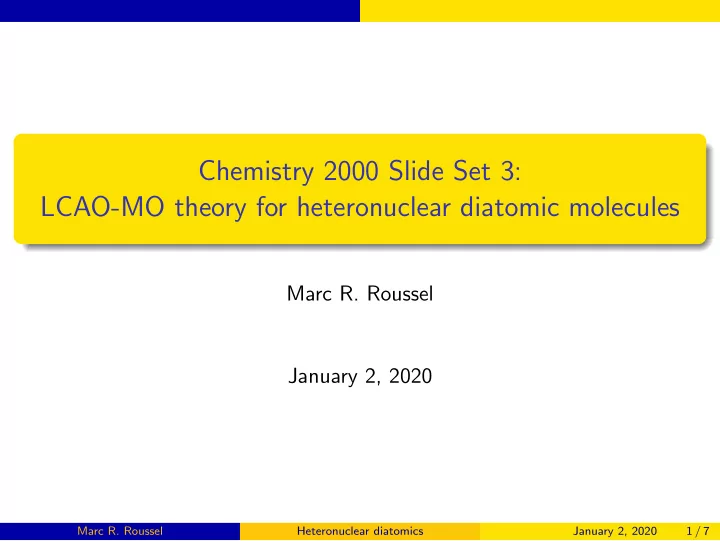

Chemistry 2000 Slide Set 3: LCAO-MO theory for heteronuclear diatomic molecules Marc R. Roussel January 2, 2020 Marc R. Roussel Heteronuclear diatomics January 2, 2020 1 / 7
Heteronuclear diatomics Key ideas used in constructing LCAO-MOs of heteronuclear diatomics: 1 Only valence orbitals of similar energy ( ± 1 Ry) mix to form an MO. 2 We can separate AOs into two sets: σ -type AOs: s and p z π -type AOs: p x and p y Only σ -type AOs are involved in σ bonding. Only π -type AOs are involved in π bonding. 3 Number of MOs constructed = number of AOs mixed Marc R. Roussel Heteronuclear diatomics January 2, 2020 2 / 7
LCAO-MO treatment of HF Valence AO energies: 0 -0.5 -1 1s 2p -1.5 ε i / R H -2 -2.5 2s -3 -3.5 -4 H F Develop MO diagram, compare to Lewis diagram. Marc R. Roussel Heteronuclear diatomics January 2, 2020 3 / 7
LCAO-MO treatment of HF (continued) New elements in the MO diagram: We get nonbonding (nb) orbitals. We generally drop the antibonding labels because this becomes harder to decide from the MO diagram alone. In a simple case like this ( σ orbitals arise from mixing one AO on each atom), it is generally the case that the lower combination is bonding and the upper is anti-bonding. Otherwise, we need to look at pictures from an MO program like Gaussian, although even that isn’t always very clear. Better: look at dependence of orbital energy on distance between nuclei. If the orbital energy increases as the nuclei move apart, the orbital is bonding; decreases, antibonding. Soon: experiments to the rescue! Marc R. Roussel Heteronuclear diatomics January 2, 2020 4 / 7
LCAO-MO treatment of CO Valence AO energies: 0 -0.5 2p -1 2p 2s -1.5 ε i / R H -2 2s -2.5 -3 -3.5 -4 C O (Develop MO diagram on board) Marc R. Roussel Heteronuclear diatomics January 2, 2020 5 / 7
CO molecular orbitals 3 σ × 2 1 π 2 σ 1 σ Marc R. Roussel Heteronuclear diatomics January 2, 2020 6 / 7
LCAO-MO treatment of CO The orbitals are polarized. As a rule, there is a larger contribution to the MO from the nearest AO in energy. Use this to discuss the Lewis acidity of CO. The ordering of the σ and π orbitals is not immediately obvious. To determine this, we can use a quantum chemistry program like Gaussian. We can however take a reasonable guess based on the fact that CO is isoelectronic with N 2 : In N 2 , the 1 π orbitals are below the 3 σ . This turns out to be the case for CO as well. Marc R. Roussel Heteronuclear diatomics January 2, 2020 7 / 7
Recommend
More recommend